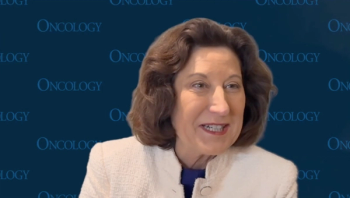
- Oncology Vol 28 No 1S
- Volume 28
- Issue 1S
(P068) CTC Levels as a Preliminary Biomarker for Non–Small-Cell Lung Cancer Patients Undergoing Radiation Therapy
This study examined circulating tumor cell (CTC) counts as measured by a novel EpCAM-independent assay and compared CTC counts with multiple known patient and tumor prognostic factors to determine the utility of pretreatment CTC levels as a preliminary prognostic biomarker for patients undergoing definitive radiation therapy (RT) for NSCLC.
Alicia E. Cutillo, Charles B. Simone, MD, Melody Ju, Lucas Gilbride, Sanjay Chandrasekaran, David Steinmetz, Jay F. Dorsey, MD, PhD, Gary D. Kao, MD, PhD, Steve M. Hahn, MD; Perelman School of Medicine, University of Pennsylvania
Background: Circulating tumor cell (CTC) assays have been shown to have prognostic utility in patients with various carcinomas, including non–small-cell lung cancer (NSCLC). However, more limited data exist assessing the relationship between CTC count and other prognostic biomarkers. Furthermore, little data exist using CTC assays that are independent of surface markers, such as epithelial cell adhesion molecule (EpCAM), and therefore impervious to downregulation and potentially more useful as a prognosticator. This study examined CTC counts as measured by a novel EpCAM-independent assay and compared CTC counts with multiple known patient and tumor prognostic factors to determine the utility of pretreatment CTC levels as a preliminary prognostic biomarker for patients undergoing definitive radiation therapy (RT) for NSCLC.
Methods: Pretreatment blood specimens were obtained on this institutional review board (IRB)-approved prospective clinical trial from patients with NSCLC who underwent 18F-fluorodeoxyglucose (18F-FDG)-positron emission tomography (PET) scans prior to starting stereotactic body radiotherapy (stage I) or concurrent chemoradiotherapy (stage III). CTC levels were identified via an adenoviral vector expressing the human telomerase (hTERT) promoter to drive expression of green fluorescent protein only in the presence of elevated telomerase activity (characteristic of almost all cancer cells but not normal cells). Patient characteristic prognosticators assessed included gender, race, and marital status, and the tumor characteristic prognosticators that were analyzed included tumor (T) stage, tumor diameter, tumor volume, histology, nodal (N) stage, clinical stage grouping, and metabolic activity on pretreatment 18F-FDG-PET. Differences and correlations between these prognosticators and pretreatment CTC levels were assessed by parametric t-tests, with statistical significance defined as P < .05.
Results: Patients had stage I (n = 9) or stage III (n = 7) NSCLC with adenocarcinoma (n = 7), squamous cell carcinoma (n = 5), or poorly differentiated not otherwise specified (n = 1) histologies, with three patients treated with empiric stereotactic body radiation therapy (SBRT) for nonhistologically confirmed, 18F-FDG PET–avid lung nodules clinically consistent with stage I NSCLC. The mean tumor volume for all patients was 73.2 cm3 (range: 1.5–377.4 cm3) and 4.3 cm3 and 161.6 cm3 for stage I and III patients, respectively. Patients had a mean maximum standardized uptake (SUVmax) on FDG-PET scan of 8.3 (range: 1.6–16.8; stage I mean 5.8, stage III mean 12.1). CTCs were detected in all patients, with a cohort mean of 26.3 per mL of blood. Elevated CTC levels significantly correlated with advanced N stage (≥ N2 vs N0–1; P = .007) and larger primary tumor volume (≥ 73.2 cm3 [mean tumor volume] vs < 73.2 cm3; P < .0001), with a trend toward significance for stage III vs stage I disease (mean 56.1 vs 3.2, P = .10). No significant correlations were seen between CTC levels and histological subtype (P = .24), SUVmax (P = .77), or demographic prognosticators, including patient gender, race, and marital status (all P > .05).
Conclusions: In this pilot study assessing CTC levels using a novel telomerase-based assay that is independent of surface markers, pretreatment CTCs were detectable in all NSCLC patients, regardless of disease extent. CTC levels strongly correlated with advanced nodal stage and tumor volume. Integration of CTC levels with other pretreatment characteristics could enhance our ability to predict clinical outcomes and, with additional studies, could potentially prove to guide treatment recommendations.
Articles in this issue
Newsletter
Stay up to date on recent advances in the multidisciplinary approach to cancer.

















































































